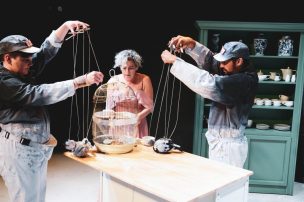
Artwork: The Victory Over Climate Change by Yukari Sakura
“The bigger the house, the more they worked to afford it, the more prescription bottles they had. I started to see the fact that I couldn’t afford to buy my daughter fancy electronics as a luxury. We went to the beach and looked for crabs under the rocks instead. We spent rainy Saturdays doing a 25-cent puzzle. I vowed never to have a house bigger than I could clean myself.”
– Stephanie Land, Vox: “I spent 2 years cleaning houses. What I saw makes me never want to be rich.” (16 July 2015)
I’ll be honest with you, Dear Reader: I don’t know a goddamn thing about Miss Julie. There are some classics (a considerable number staged at Cutting Ball) that, when revived and adapted, I know instantly. I get what producers do and don’t change about an Ibsen piece; I like seeing new versions of Shaw; and I almost think Shakespeare now exists solely for reinterpretation. But somehow Strindberg’s Miss Julie never popped up on my radar. As such, I find nothing about revising it sacred or profane.

Julie (Stacy Ross) is just so tired of it all. Photo by Estela Hernandez
I do, however, know Megan Cohen’s writings. I’ve watched them, I’ve read them, I’ve successfully auditioned with them. As San Francisco theatre’s one true absurdist playwright, Cohen’s kaleidoscope of characters have ranged from criminal rabbits and bulls, a sentient form of media programmed to “do what [he] wernt”, a hard-drinking bear, anti-patriarchal horses, Arthurian knights who just want beer, and… the Dumplings. God help us all, the Dumplings. And those are just ones I can remember off the top of my head.
If anything, the most surprising thing about Cohen’s involvement in this play is the fact that she’s involved at all. As I’m off social media now, I’m the last to learn about everyone’s major life changes (if I learn of them at all), and when the last thing I’d heard about Megan was that she’d, quote, “gone to Texas to make operas, or whatever”, I figured the Bay Area had permanently lost another unique artistic voice. So when I found out that she and Ariel Craft were getting together to deconstruct a-play-I-didn’t-give-a-fuck-about-to-begin-with… I figured, “Yeah, I’ll take a look at it.”
And, true to Cohen’s wonderfully Absurdist instincts, the play is set in a snow-topped San Francisco. I was born and raised here, and I’ve never seen real snow at all, let alone in San Francisco. Yet, we begin with rich-chick Julie (Stacy Ross) skiing down Nob Hill as she contemplates everything from the weather – which plays an important role – to how much she doesn’t want to attend the very party happening in her home tonight. Her cascade concludes with her crashing head-first into John (Phil Wong), whom she mistakes for a complete stranger – he’s her sous chef.

John (Phil Wong, right) doesn’t know any more about Julie (Stacy Ross, second-from-left) than she does about him. The workers (Miyaka P. Cochrane and Charlie D. Gray) know more than they say. Photo by Ben Krantz.
Tonight’s party for the 1% – of which Julie and her unseen mother are part – is called the “End of Snow” Party, in which the blue-bloods will watch as global warming becomes radically realized via a near-biblical flood expected to possibly make Nob Hill “beachfront property”. Julie refuses to believe this is really the end. John is already planning for the apocalypse.
Thus we have our scenario: privileged Julie believes one can escape whenever they want; lower-class John just doesn’t want to be trapped. But what relevance is class when it’s the end of the fucking world?
I’d rather not say much more – both because I don’t want to spoil things and because, in typical Cohen fashion, it has to be seen to be believed. Rest assured that before this apocalyptic farce is over, we’ll meet a few more hilarious characters. We’ll meet two pompous, rich assholes who spill more bubbly than they sip as they wane on about doing lower-classes a favor by denying them equality. We’ll meet a pair of pigeons whose fates may or may not be tied to our main characters. And we’ll meet Christine, Julie’s maid and John’s co-worker, on whom he has a crush.

These two blue-bloods (Phil Wong and Stacy Ross) haven’t a thing to worry about at the end of the world. Photo by Ben Krantz.
The rich assholes are also played by Ross and Wong, the former (whose poorly-sticking moustache just added to the farce) having set his eyes on his latest underage – and, likely, non-consenting – conquest at the party. The simplicity of these two contrasts with the complexity of Julie and John. John has always admired Julie’s house on the hill, but is now disgusted by what he knows of this world. Julie flees to the kitchen to escape the monotonous terror of her party, but when she seeks a “genuine” experience from John, her brain seems unable to make the connection between her exploitation of him and the misogyny she laments so much. She constantly downs the deviled eggs John makes for Christine, criticizes him for using Napa olive oil rather than that from Italy, and mocks him for not exercising the freedom she takes for granted.
Yet, John is no angel. His obsession with Julie is fuckin’ creepy, his lack of honesty about Christine is dickish, and even he has an unearned sense of superiority. The play’s most powerful scene is an extended sequence in which Julie begins playing power-focused mind games with John. When he is seemingly given the same power she has, I was reminded of what Robert Caro said: “What I believe is always true about power is that power always reveals. When you have enough power to do what you always wanted to do, then you see what the guy always wanted to do.” Julie and John have a BDSM dynamic that only seems to be equal, but Julie never truly relents her power and John reveals an ugly side of himself when given even the illusion of power.

Julie (Stacy Ross, center) takes a fun slide down Nob Hill (represented by puppeteers Charlie D. Gray and Miyaka P. Cochrane). Photo by Ben Krantz.
It’s wise then that Cohen and Craft side-step any explicit mention of race. Really, I have mixed feelings about that. One the one hand, it’s good that these two White women didn’t try to replicate the voice of a person of color. On the other hand, it’s still staged with a White woman and Asian man. Julie waxes at length about the anger she feels of being defined solely by her gender and age. A person of color – and I say this first-hand – certainly would have that frustration of being defined by their race, especially when being subservient to rich White people. So, the absence of any direct acknowledgement is as irritating as it is well-played. “Damned if you do, damned if you don’t.”
Fortunately, the combined talents of these two have assembled a fine collection of performers to pull off their tragicomic vision. Both Julie and an incredibly horny rich dick are played by Stacy Ross. I last saw Ross bring an incredible amount of depth to the rather shallow script of Branden Jacob-Jenkins’ Everybody at Cal Shakes. She does equally well here with a much better script. Julie isn’t dumb or heartless, her brain is simply hard-wired to focus on things of immediate importance to her alone. She brings a lot of heart to the role and has great chemistry with Phil Wong, a performer whose work I don’t recall, but who’s directorial work for Killing My Lobster I’ll be observing later this week. He, too, brings the right amount of depth to a role that could have been bogged down in self-pity.
Joining our two top-billed are three puppeteers dressed as blue-collar painters. They not only animate the aforementioned pigeons (as well as a sentient pack of cigarettes), but also Jacqueline Wren Scott’s spartan(-seeming) set. They’re the only seen characters who rank lower than John, so not even can see them (the same way Julie couldn’t see him before she crashed into him). The trio are played by Miyaka P. Cochrane, a woman unidentified in the program, and a scene-stealing Charlie Gray. Although Gray’s unnamed worker says only one word at the very end, the accomplished puppeteer and vaudevillian gives the best silent commentary on our leads throughout the show. Let me put it this way: there’s a damn-good reason why I wrote “Fuckin’ Charlie Gray’s side-eye! LOL” in my notes.

Julie (Stacy Ross, center) cares more for birds (puppeteered by Charlie D. Gray and Miyaka P. Cochrane) than people. Photo by Ben Krantz.
The aforementioned set by Scott is a cute collection of subtle secrets. At first appearing to be purely minimalist – with nothing more than hanging white sheets, like a room about to be painted – the sheets are subtly meant to resemble the “snow-covered hills” of a Stevie Knicks song. Quickly and discreetly, they fall to reveal lime-green Victorian set pieces that just scream “old San Francisco”. This aided by Cassie Barnes’ lights (I actually wondered at the start whether the set floor was blue or whether it was Barnes’ lights shining from overhead) and James Ard’s sound collection of whooshing skis, flapping birds, a massive flood, and even just cocktail party chatter. Costumer Rachael Heiman’s threads are best in their minor details. Not just Julie’s pink dress or John’s stitched uniform, but also in how the worker’s jumpsuits include hats with interchangeable name tags (for instance, one will say “Nob”, the other “Hill”, before both reading something different in the next scene).
I don’t really want to give away the contribution of intimacy choreographer Maya Herbsman, but… well… let’s just say there’s an entire sequence devoted to her contribution. You’ll know it when you see it. Still, fine work all around.
I’m glad to see that the Bay Area can still count on the talents of Megan Cohen and Ariel Craft to deliver unexpected and intriguing work. Using this fair city as the backdrop for a class warfare comedy against the backdrop of a Pompeii-esque disaster is both inspired and accomplished well.
The show isn’t perfect: the unspoken racial aspect is just too big for me (personally) to ignore. There’s also the fact that this show has now ruined Miss Julie for me. Like I said above, I haven’t read or seen that show, but when I inevitably do, I expect to be disappointed that it doesn’t have soon-to-be climate refugees contemplating the limits of power over deviled eggs as marionette pigeons fly in the background.
This is now my head-canon. Tough shit, Strindberg.
GRADE: A-
Free for All is scheduled to run until the 20th of October at the EXIT on Taylor in San Francisco, CA.
The show runs roughly 1 hour 45 min. with no intermission.
For tickets and information, please visit the production’s official site here.
Categories: Theatre











6 replies »